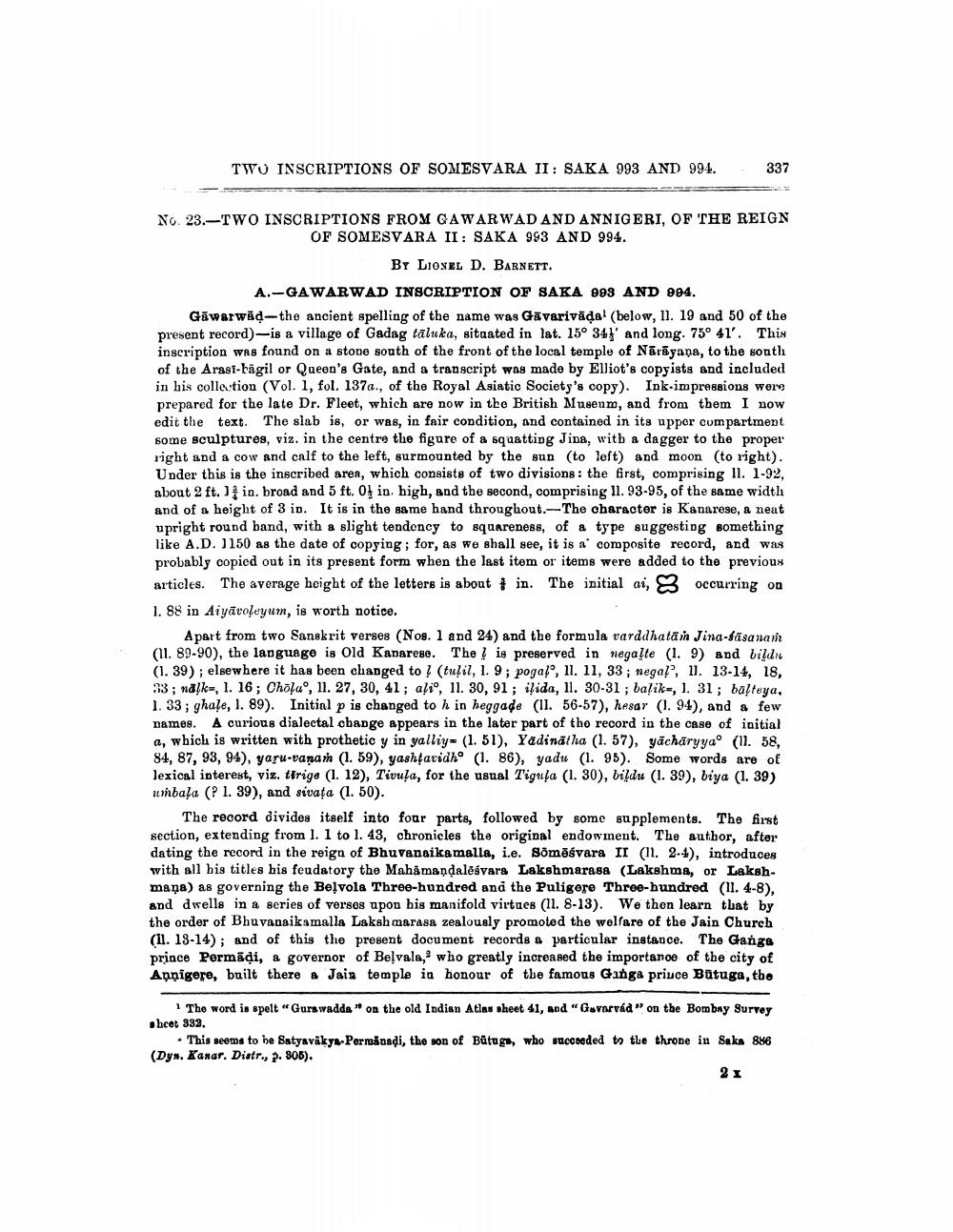________________
TWO INSCRIPTIONS OF SOMESVARA II: SAKA 993 AND 994.
337
No. 23.-TWO INSCRIPTIONS FROM GAWARWAD AND ANNIGERI, OF THE REIGN
OF SOMESVARA II: SAKA 993 AND 994.
BY LIONEL D. BARNETT. A.-GAWARWAD INSCRIPTION OF SAKA 993 AND 994. Gāwarwād-the ancient spelling of the name was Gāvarivādal (below, 11. 19 and 50 of the present record)-is a village of Gadag taluka, sitaated in lat. 15° 34' and long. 75° 41'. This inscription was found on a stone south of the front of the local temple of Nārāyana, to the south of the Arasi-bagil or Queen's Gate, and a transcript was made by Elliot's copyists and included in his collection (Vol. 1, fol. 137a., of the Royal Asiatic Society's copy). Ink-impressions were prepared for the late Dr. Fleet, which are now in the British Museum, and from them I now edit the text. The slab is, or was, in fair condition, and contained in its upper compartment some sculptures, viz. in the centre the figure of a squatting Jina, with a dagger to the proper right and a cow and calf to the left, surmounted by the sun (to left) and moon (to right). Under this is the inscribed area, which consists of two divisions: the first, comprising 11. 1-92, about 2 ft. fin. broad and 5 ft. Oļ in high, and the second, comprising 11. 93-95, of the same width and of a height of 3 in. It is in the same hand throughout.--The character is Kanarese, a neat upright round band, with a slight tendency to squareness, of a type suggesting something like A.D. 1150 as the date of copying; for, as we shall see, it is a composite record, and was probably copied out in its present form when the last item or items were added to the previous articles. The average height of the letters is about #in. The initial ai, s occurring on 1. 88 in Aiyāvoleyun, is worth notice.
Apart from two Sanskrit verses (No. 1 and 24) and the formula varddhatan Jina-fasanavi (II. 89-90), the language is Old Kanarese. The ! is preserved in negalte (1.9) and bildi. (1. 39); elsewhere it has been changed to ? (tulil, 1. 9; pogal, 11. 11, 33; negal, 11. 13-14, 18, 33; nāļk-, 1. 16; Chola, 11. 27, 30, 41; alio, 11. 30, 91 ; ilida, 11. 30-31 ; baliks, 1. 31; balteya, 1.33; ghale, I. 89). Initial p is changed to h in heggade (II. 56-57), hesar (1. 94), and a few names. A curious dialectal change appears in the later part of the record in the case of initial a, which is written with prothetic y in yalliy= (1. 51), Yadinātha (1. 57), yācharyyao (II. 58, 84, 87, 93, 94), yaru-vanaih (1. 59), yashtaridho (1. 86), yadu (1. 95). Some words are of lexical interest, viz. tirige (1. 12), Tivula, for the usual Tigula (1. 30), bildu (1. 39), biya (1. 39) umbala (? 1. 39), and sivata (1.50).
The record divides itself into four parts, followed by some supplements. The first section, extending from 1.1 to 1. 43, chronicles the original endowment. The author, after dating the record in the reign of Bhuvanaikamalla, i.e. Sömēsvara II (11. 2-4), introduces with all bis titles his feudatory the Mahamandalesvars Lakshmarasa (Lakshma, or Lakshmaņa) as governing the Beļvola Three-hundred and the Puligere Three-hundred (II. 4-8). and dwells in a series of versos upon his manifold virtues (11. 8-13). We then learn that by the order of Bhuvanaikamalla Laksh marasa zealously promoted the welfare of the Jain Church (II. 13-14); and of this the present document records a particular instance. The Ganga prince Permādi, a governor of Belvala, who greatly increased the importance of the city of Annigere, built there & Jain temple in honour of the famous Ganga priuce Būtuga, the
The word is spelt "Gurawadda" on the old Indian Atlas sheet 41, and "Govorvád" on the Bombay Survey sheet 332.
• This seems to be Satyaváky-Permånadi, the son of Bütuga, who scoreded to the throne in Saka 886 (Dyn. Kanar. Distr., p. 805).
2




